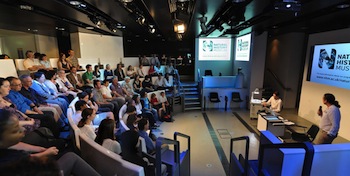Haivision’s Mako Featured at Darwin Centre

The new Darwin Centre at the Natural History Museum in London is a state-of-the-art science and collections facility, an eight-story-high cocoon in which visitors can learn about the museum’s research and watch its scientists at work. The center’s Attenborough Studio is a high-tech audio-visual venue that provides 64 seats for a variety of events, shows, and films about all aspects of life on Earth and scientific discovery. In this studio, visitors have the opportunity to interact with scientists working in the Darwin Centre laboratories and in the field.
- In the studio, advanced two-way communication technology from Haivision Network Video allows students and other visitors to view scientists on five large high-definition (HD) displays. The low-latency encoding provided by the Haivision Mako codec enables real-time interaction between scientists in “the field” and visitors in the studio.
- Haivision’s Mako gives the museum a two-way, two-channel broadcast-quality audio and video link between any two points on its LAN. One Mako is installed in a field-deployable flight case system on a trolley that can be rolled without putting any vibration on the equipment. This trolley may be moved throughout the laboratories in the Darwin Centre, and museum staff members currently use the trolley to link a laboratory into the lecture theater. Going forward, however, the portable encoding solution could be moved and used in the same way anywhere on the Super Janet (Joint Academic Network), an academic network that covers the United Kingdom, with some links in excess of 1 Gbps. With Super Janet, a multicast-enabled network, the Haivision HD encoding system may be transported and used anywhere in the country.
- A second Mako is located in the Attenborough Studio, where the video is projected onto five screens: one large 8-foot-wide HD display and four other smaller HD displays. The museum currently uses its Haivision system to encode video from a Sony HDW-EX3 HD camcorder (HD-SDI out).
- The Mako’s most valued features for this project are its low end-to-end latency of less than 70 ms and resolutions of up to 1080p, which yield an unmatched live video viewing experience. Haivision’s H.264 compression technology makes this possible at a low bit rate. The museum is using four channels of audio between the mobile unit in the laboratories and the auditorium, along with one microphone for the scientist and one radio microphone for the presenter, who can pass it around to any member of the audience. This configuration allows the audience to see the laboratory as they ask questions to the scientists.
- A back channel with an earpiece allows the scientists to have a live conversation with the control studio. This studio talk-back feature allows the control room staff to maintain communication with the coordinator during the live session. At each end of the link, typically in the lab and in the Attenborough Studio, camera operators can listen to the control room while the scientists talk to the audience. At the same time, the staff in the control room can see and hear all the communications between the scientists and the audience.
- “The Natural History Museum had a clear vision of a presentation area that would provide our visitors with a truly unique experience,” said Jez Burn, head of special effects at the Natural History Museum. “We wanted to utilize the world’s leading technology to create a state-of-the-art communication centre that would lead the way as both an educational facility and a premier visitor attraction. The Attenborough Studio in the Darwin Centre now allows the public to share the excitement of discovery in new and innovative ways.”
A daily selection of the top stories for AV integrators, resellers and consultants. Sign up below.
The AVNetwork staff are storytellers focused on the professional audiovisual and technology industry. Their mission is to keep readers up-to-date on the latest AV/IT industry and product news, emerging trends, and inspiring installations.
